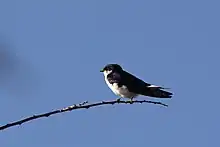| Hirundo | |
|---|---|
 | |
| A barn swallow collecting nest material in Germany | |
| Scientific classification | |
| Domain: | Eukaryota |
| Kingdom: | Animalia |
| Phylum: | Chordata |
| Class: | Aves |
| Order: | Passeriformes |
| Family: | Hirundinidae |
| Subfamily: | Hirundininae |
| Genus: | Hirundo Linnaeus, 1758 |
| Type species | |
| Hirundo rustica (barn swallow) Linnaeus, 1758 | |
| Species | |
|
See text | |
The bird genus Hirundo is a group of passerines in the family Hirundinidae (swallows and martins). The genus name is Latin for a swallow.[1] These are the typical swallows, including the widespread barn swallow. Many of this group have blue backs, red on the face and sometimes the rump or nape, and whitish or rufous underparts. With fifteen species this genus is the largest in its family.
Taxonomy
The genus Hirundo was introduced in 1758 by the Swedish naturalist Carl Linnaeus in the tenth edition of his Systema Naturae.[2] The genus name is the Latin word for a swallow.[3] Linnaeus included eight species in the genus and of these William Swainson designated the barn swallow (Hirundo rustica) as the type species.[4][5]
Extant species
The genus contains fifteen species. The linear sequence is based on two molecular phylogenetic studies published in 2005 and 2018.[6][7][8]
| Image | Common name | Scientific name | Distribution |
|---|---|---|---|
 |
Black-and-rufous swallow | Hirundo nigrorufa | Angola, Democratic Republic of the Congo and Zambia. |
| Blue swallow | Hirundo atrocaerulea | from South Africa to Tanzania | |
.jpg.webp) |
Pied-winged swallow | Hirundo leucosoma | Benin, Burkina Faso, Cameroon, Ivory Coast, Gambia, Ghana, Guinea, Guinea-Bissau, Mali, Niger, Nigeria, Senegal, Sierra Leone, and Togo. |
 |
White-tailed swallow | Hirundo megaensis | Oromia, Ethiopia. |
.jpg.webp) |
Pearl-breasted swallow | Hirundo dimidiata | southern Africa from Angola, southern Congo and Tanzania southwards. |
 |
Pacific swallow | Hirundo tahitica | southern Asia and the islands of the south Pacific. |
_by_Dharani_Prakash.jpg.webp) |
Hill swallow | Hirundo domicola | southern India and Sri Lanka. |
 |
Welcome swallow | Hirundo neoxena | Australia and nearby islands |
_(6817418149)_(cropped).jpg.webp) |
White-throated swallow | Hirundo albigularis | southern Africa from Angola and Zambia southwards to the Cape in South Africa. |
.jpg.webp) |
Wire-tailed swallow | Hirundo smithii | southern Africa and southeastern Asia. |
_(cropped).jpg.webp) |
White-bibbed swallow | Hirundo nigrita | Angola, Benin, Cameroon, Central African Republic, Republic of the Congo, Democratic Republic of the Congo, Ivory Coast, Equatorial Guinea, Gabon, Ghana, Guinea, Guinea-Bissau, Liberia, Nigeria, Sierra Leone, and Uganda. |
 | Barn swallow | Hirundo rustica | North and South America, most of Africa aside from the Sahara Desert, most of Eurasia aside from the northern Siberia, and northern Australia. |
 | Angola swallow | Hirundo angolensis | Angola, Burundi, Democratic Republic of the Congo, Gabon, Kenya, Malawi, Namibia, Rwanda, Tanzania, Uganda, and Zambia. |
.jpg.webp) | Red-chested swallow | Hirundo lucida | West Africa, the Congo Basin and Ethiopia. |
.jpg.webp) | Ethiopian swallow | Hirundo aethiopica | Benin to Burkina Faso, Cameroon, Central African Republic, Chad, Democratic Republic of the Congo, Ivory Coast, Eritrea, Ethiopia, Ghana, Guinea, Israel, Kenya, Mali, Niger, Nigeria, Senegal, Somalia, Sudan, Tanzania, Togo, Uganda |
Extinct species
There are at least two fossil species included in this genus:
Former species
Some authorities, either presently or formerly, recognize several additional species as belonging to the genus Hirundo including:
- West African swallow (as Hirundo domicella)[10]
Distribution and habitat
All of the species are found in the Old World, although one, the barn swallow, is cosmopolitan, also occurring in the Americas.
Gallery
 H. rustica foraging
H. rustica foraging Windows in the tail of H. rustica
Windows in the tail of H. rustica Tail streamers of H. smithii filifera
Tail streamers of H. smithii filifera Nest of H. rustica
Nest of H. rustica Clutch of H. rustica gutturalis
Clutch of H. rustica gutturalis Clutch of H. smithii
Clutch of H. smithii
References
- ↑ Jobling, James A (2010). The Helm Dictionary of Scientific Bird Names. London: Christopher Helm. p. 193. ISBN 978-1408125014.
- ↑ Linnaeus, Carl (1758). Systema Naturae per regna tria naturae, secundum classes, ordines, genera, species, cum characteribus, differentiis, synonymis, locis (in Latin). Vol. 1 (10th ed.). Holmiae (Stockholm): Laurentii Salvii. p. 191.
- ↑ Jobling, James A. (2010). The Helm Dictionary of Scientific Bird Names. London: Christopher Helm. p. 193. ISBN 978-1-4081-2501-4.
- ↑ Swainson, William John (1837). On the Natural History and Classification of Birds. Vol. 2. London: John Taylor. p. 340.
- ↑ Dickinson, E.C.; Christidis, L., eds. (2014). The Howard & Moore Complete Checklist of the Birds of the World. Vol. 2: Passerines (4th ed.). Eastbourne, UK: Aves Press. p. 479. ISBN 978-0-9568611-2-2.
- ↑ Sheldon, Frederick H.; Whittingham, Linda A.; Moyle, Robert G.; Slikas, Beth; Winkler, David W. (April 2005). "Phylogeny of swallows (Aves: Hirundinidae) estimated from nuclear and mitochondrial DNA sequences". Molecular Phylogenetics and Evolution. 35 (1): 254–270. doi:10.1016/j.ympev.2004.11.008. ISSN 1055-7903. PMID 15737595.
- ↑ Silva, Thilina N. de; Fernando, Sumudu W.; Robbins, Mark B.; Cooper, Jacob C.; Fokam, Eric B.; Peterson, A. Townsend (2018). "Recognition of a new generic-level swallow taxon from central Africa". Journal of Avian Biology. 49 (9): e01698. doi:10.1111/jav.01698. ISSN 1600-048X. S2CID 90611033.
- ↑ "Taxonomic Updates – IOC World Bird List". Retrieved 2021-08-16.
- 1 2 Kessler, E. (2013). Neogene songbirds (Aves, Passeriformes) from Hungary. Hantkeniana Budapest 8: 37-149.
- ↑ "Cecropis domicella - Avibase". avibase.bsc-eoc.org. Retrieved 2017-05-05.